| |
The
1947 Friendship Train in California
by
Dorothy R. Scheele
Los Angeles,
California, was the starting point for America’s Friendship
Train, a departure which was truly an extravaganza. Spotlights splashed
across the sky. Thousands of spectators were thrilled to be part
of this occasion and to see the many celebrities. Among the celebrities
participating in the ceremony were Eddie Cantor, Liz Taylor, and
John Wayne. These festivities were a kick-off rally. For logistical
reasons, the actual train was being loaded in nearby Glendale.
The cargo of
this unique train consisted of 12 boxcars from the Los Angeles area.
Among those contributing to the train were the Screen Actors Guild
which donated a boxcar of macaroni; Long Beach which donated a boxcar
of sugar; and Glendale, which contributed one boxcar of flour. The
Los Angeles area had donated a total of 12 boxcars, an inspiration
to the rest of the nation for contributions.
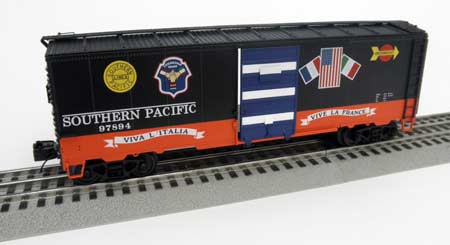
When the long-awaited
final moment came, station agent Frank R. Kirkland stated, “This
is it.” His brief statement indicates how much excitement the train
created. The remarks of Rev. Clarence H. Parlous of St. Mark’s Episcopal
Church emphasized the excitement. “God bless this endeavor. God
speed the train. God speed the peace.”
At 11:00
p.m. in Los Angeles, the Friendship Train began its phenomenal,
historical cross-country odyssey. Eleven days later the journey
would end in New York City.
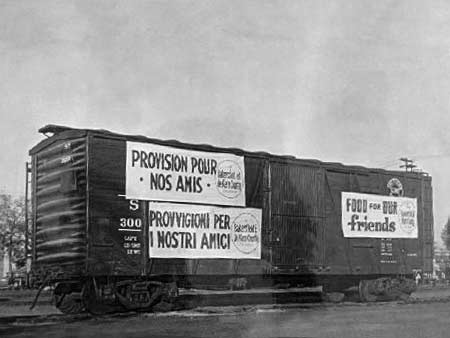
The next
morning the train’s first stop was Bakersfield. Some of the
dignitaries present were Judge and Mrs. Norman Main, Mayor Vanderlei,
and W. R. Woollomes, chairman of the Friendship Train. Gov. Warren,
a native of Bakersfield, spoke. Local speakers included James Petrini,
who spoke on behalf of the Bakersfield Italian community, and Sheriff
John Loustalo, who spoke for the French community. Adding color
to the crowd was a number of men who were heavily-bearded and dressed
in the western garb of pioneer days. The men, reenacting an earlier
time in our history, were participating in an afternoon parade and
rodeo sponsored by the American Legion. The Friendship Train blasted
off--one boxcar longer.

Even though
the Friendship Train was not scheduled to arrive in Fresno until 11:00, the city was out early in anticipation. A parade of
local leaders, led by Charles Marsells, assembled at the Pacific
Railroad yard at Kern Street for the ceremony. More than five thousand
spectators and approximately ten bands greeted the train. High school
students carried banners declaring, “Welcome Friendship Train, Raisins
for France, Raisins for Italy and Friendship from Fresno, California.”
The Fresno Bee station KMJ broadcast the thrilling occasion to the
entire San Joaquin Valley.
Greeting the
Friendship Train’s dignitaries were Mayor Glenn M. DeVore, Claude
H. Ketchum, and Scott K. Wood. Ketchum and Wood had been prominent
in heading the Fresno Citizens Food Saving Committee. After brief
speeches by the officials, several French and Italian war brides,
Mrs. Robert Jacobson, Mrs. Denise Englander, and Mrs. Lina Gayer,
thanked the spectators for their donations to their former countrymen.
Fresno’s
gift to the Friendship Train was a carload of raisins and dried
figs, financed chiefly by the raisin and wine industry. Forty-five
minutes after its arrival, the train for Merced, its next stop.
A large crowd
turned out in Merced to greet afternoon arrival of one of history’s
most salient examples of our common humanity. Fay Batten, a well-known
farmer from Dos Palos, delivered the welcoming address, and local
citizen R. B. Cross and Mayor J. E. Fritz spoke briefly. The two
boxcars attached to the train were filled with the suggested staples
and with condensed milk, Merced’s main contribution. Stanislaus
County had contributed half a boxcar to the train.
Both civilians
and the military at Castle Field Military Base had a great
time collecting for the train: they built a miniature Friendship
Train. This small replica consisted of a jeep, which had been decorated
to resemble a locomotive, and three ‘freight cars.’ The ‘engineer’
drove it around the base, collecting 350 cases of milk, and then
the little train, escorted by the police and the military band,
drove through Merced’s streets to the loading area. Imaging this
little train, the bands, and the enthusiastic people creates a picture
of how much fun the country had had with collecting food for our
fellow Europeans.
After its brief
stop in Merced, the train left for Stockton where more than 3,000
spectators greeted it. The thirty-five piece Musicians Association
Band heralded the arrival, as young women dressed in French and
Italian costumes, enhanced the celebratory spirit. Cub Scouts carried
signs with welcoming messages. Mayor Woodrow Coale was among those
greeting Pearson and Gov. Warren.
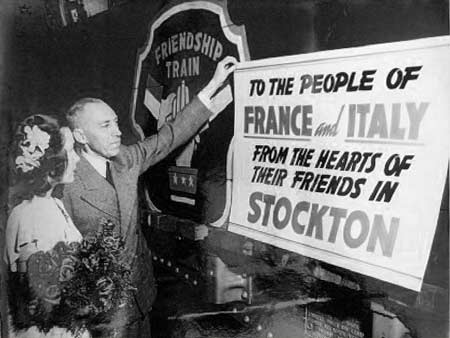
Stockton’s
contribution consisted of 37 tons of nutrition. Stockton Unified
School District and the College of the Pacific worked assiduously
to encourage contributions. Of the 17,752 cans of milk the schools
donated, Woodrow Wilson School collected the most, a total of 3,034
cans. The students and faculty of the College of Pacific and Stockton
Junior College gave a combined 3,000 cans of condensed milk. The
Chamber of Commerce collected the money contributions, and 20 members
of Archania, Omega Phi Alpha, and Rhizomia fraternities of College
of Pacific volunteered to help pack food. The train departed for
Oakland, Stockton’s car carrying its identifying banner.
A parade which
had no equal in the entire history of the city welcomed the Friendship
Train to Oakland. Such was the declaration of Jack Berman,
chairman of the local Friendship Train committee. Beginning at 20th
and Franklin Streets with a police color guard and motorcycle escort,
the long line wound through the streets. Twenty six full-size bands,
ranging from the American Legions and VFW posts, local high schools,
the University of California, Boy Scouts and others, along with
drill teams, played and marched in honor of the Friendship Train.
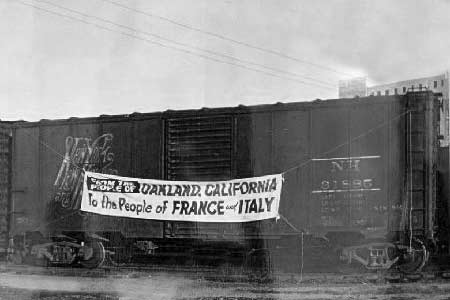
The train arrived
at the Southern Pacific station at 7:45 p.m. floodlights illuminating
the night sky. Several thousand people witnessed the exciting civilities.
Stations KLY, KROW, and KRE broadcast the program.
Participating
in this singular event, in addition to the regular Friendship Train
dignitaries, were Mayor Joseph Smith of Oakland, other Bay area
mayors, and Gov. Ingram Stainback of Hawaii, their messages exploding
over loudspeakers to the excited audience.
Oakland had
implemented a well-organized food and cash campaign. The November
7th Oakland Tribune had printed an article with directions for purchasing
food and for sending cash. Berkeley school children and their teachers
turned in $1,508. An interesting contribution came from the International
House of the University of California: seven hundred students skipped
dinner one evening so that the cost of the meal would be sent to
the Friendship Train fund; $350 resulted from their willingness
to be part of this enormous movement.
Hawaii’s
two carloads of sugar were added to the Oakland cars. The Gerber
Company donated a full carload of baby food, valued at $10,000.
Vallejo donated a carload of flour. San Leandro, immediately adjacent
to Oakland, delivered its donation in 19 “silvered barrels” packed
by the local fire department.
Although officials
originally anticipated filling five boxcars, Oakland’s total reached
seven. A part of the city’s donation which had arrived too late
to be shipped on the train was sent free by California Eastern Airways.
The Friendship Train remained overnight in Oakland and departed
at 8:00 in the morning for Sacramento, its final stop in the Golden
state.
On Sunday morning
cheered by a crowd of 7,000, the Friendship Train roared into the
Southern Pacific Station in California’s capital. Newsreels recorded
the welcoming ceremony for later showing in France and Italy, and
radio station KFBK broadcast it nationwide. Bands from the Sacramento
College, the fire department, and the musicians’ union provided
some of the entertainment.
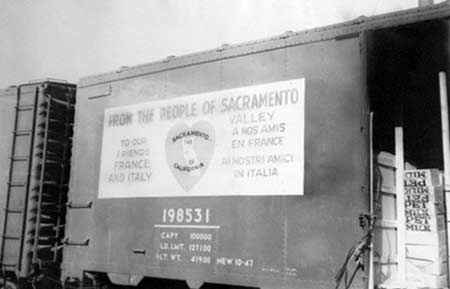
Sacramento’s
Mayor George L. Klumpp arrived with the Friendship. Officials spoke
briefly, and French war bride, Christine Harris, wife of Ray Harris
of Sacramento, thanked the crowd for the aid they gave to her countrymen.
Sacramento
added two cars to the Friendship Train. Cash amounting to $2,712,
some of it arriving too late to purchase food for the boxcars while
they were there, was forwarded to New York for additional purchases.
Sacramento’s cars, painted red, white, and blue, bore a map of California
showing the city as the heart of the state. On the boxcars also
was a message which reflected the feelings of all America about
the Friendship Train, “To our friends in France and Italy, from
the people of Sacramento.” The train left the Golden State with
27 boxcars of nourishment.
As was the policy
when the train left one state and entered another, the governors
of the respective states departed or boarded. Hence, as the Friendship
Train left California, Gov. Warren officially handed it to Gov.
Vail Pittman of Nevada, who escorted it into Reno, the first stop
in the Silver State.
List of Works Consulted
1. "Friendship Train Given Send-off in Hollywood," Los Angeles Times, Nov. 8, 1947, Part 1: 6. [hereinafter "Friendship Train."] Unless otherwise stated, the information is from this article.
2. Pearson, Drew. "The Washington Merry-Go-Round," Nevada State Journal, Nov. 9, 1947: 4.
3. Film Stars to Aid Food Train Parade Tomorrow," Los Angeles Times, Nov. 6, 1947, Part 1: 6. [Hereinafter "Film Stars."]
4. "Film Stars."
5. "Friendship Train Loading to Begin," Los Angeles Times, Nov. 5, 1947, Part 1: 2.
6. "Friendship Train Day Proclaimed by Mayor," Los Angeles Times, Nov. 4, 1947, Part III: 16.
7. Long, Tania. "Pictures of an Average French Family," New York Times Magazine, Mar. 14,1948: 13.
8. Pearson, Drew. "The Washington Merry-Go-Round," Illinois State Register, Nov. 18, 1947: 1+.
9. Pearson explicitly stated some of his thoughts regarding the founding of the Friendship Train in the "Merry-Go-Round" column appearing in the Advance Register [Tulare, CAl Oct. 27, 1947: 1. " ... the people of western Europe [will] get the full significance of this American generosity, [sic] there won't be any doubt as to whose side they will be on. That, of course, is one big reason for the Friendship Train, and why newsreels of the train will be shown in European theaters, and why the French and Italian embassies are working on the ideas of meeting the food shipments on the other side with two European 'Friendship trains to carry the cargoes from the French and Italian seaports through Italy and France.'" This was just one of many volunteer relief efforts of the time, though possibly the largest. Indeed, there was also a Friendship Train of food for Germany. See the oral history of Arthur Ringland, Executive Director, Advisory Committee on Voluntary Foreign Aid, Department of State, 1946-1953 at www.trumanlibrary.org/oralhist/ringland
10. A very loose connection with the United States government existed in that President Truman heartily endorsed it. (see '''Friendship Train to Roll Out of Valley' Washington Merry-Go-
Round," Advance Register [Tulare, CA], Oct. 27, 1947: 1.
11. "Seattle's 'Friendship' Car of Food Departs," Seattle Daily Times, Nov. 6, 1947: 20.
12. "City Awaits Arrival of Friendship Train" Evening Bulletin [Philadelphia] Nov. 17, 1947: 1.
13. "Good Will Train Grows," York Dispatch [York, PAl, Nov. 10,1947: 1.
14. Pearson, Drew. "The Washington Merry-Go-Round," Intelligencer Journal [Lancaster, PA], Nov. 1,1947: 10.
15. "Hundreds of Persons in Tribute," News-Press [Glendale], Nov. 8, 1947:1+. Unless otherwise stated, the information on Glendale and the Friendship Train is from this article.
16. "Carload of Flour Gift From City," News-Press [Glendale],Nov. 7, 1947: 1.
17. Pearson, Drew. "The Washington Merry-Go-Round," Gazette and Daily [York, Pa.], Nov. 7, 1947: 28.
18. "3,000 Greet Friendship Train at Stop for Kern Wheat Gift," Bakersfield Californian, Nov. 8, 1947: 1+. Unless otherwise indicated, all information is from this article.
19. "Friendship Train Leaves L.A.," Bakersfield Californian, Nov. 7, 1947: 1. [Hereinafter "Train Leaves."]
20. "Train Leaves."
21 "Friendship Train Campaign Gains Speed With Gifts," Bakersfield Californian, Nov. 5, 1947: 13.
22. "Train Fund Nearing Goal," Bakersfield Californian, Nov. 6,1947: 13.
23. "Kern County Friendship Train Cash Dash Donations Exceed $7,500," Bakersfield Californian, Nov. 11, 1947:12.
24. "Warren Lauds Fresno's Gift to Food Train as Contribution to Peace," Fresno Bee,Nov. 9, 1947:Al+. [Hereinafter "Warren Lauds."]
25. "Warren Lauds."
26. "Generous Fresnans Speed Friendship Train on Way With Car of Food," Fresno Bee, Nov. 8, 1947: 1+. The journey of the train to Fresno was broadcast. A group of KMJ radio specialists joined the train between Fresno and Bakersfield and narrated their progress. The ceremony was recorded on motion pictures in order to be shown later in France and Italy. [Hereinafter "Generous Fresnans."]
27. "Large Crowd Expected to Greet Friendship Train Here Saturday," Merced Sun-Star, Nov. 7, 1947: 1.
28. "Friendship Train Gets Two Cars of Food Here," Merced Sun-Star, Nov. 8, 1947: 1. Volunteers from A.F. of L. Teamsters Union and members of the 20-30 Club packed the cars. Boy Scouts, 4-H Club members and Future Farmer members helped extensively with collecting the food. Picture "Loading Food for Friendship
Train,"Merced Sun-Star, Nov. 8, 1947: 1.
29. "17,500 Cans of Milk Donated by Air Base," Merced Sun- Star, Nov. 11, 1947 : 7.
30. "Food Aid Train Due Tomorrow," Stockton Record, Nov. 7,1947: 17.Alocal speaker at the forty-five minute ceremony was Don Smith of Huntington Park, state President of the Junior Chamber of Commerce."Friendship Train Is Greeted by 3,000 Here," Stockton Record, Nov. 10, 1947:13. L.G. Tavolara, manager of the Fox California Theater, was in charge of the ceremony. "Stockton to Welsome Friendship Train With Saturday Festival," Stockton Record, Nov. 5, 1947: 17. Earl Russell, local radio announcer, was master of ceremonies. "Friendship Train Is Greeted by 3,000 Here," Stockton Record, Nov. 10, 1947: 13.
31. "Friendship Train Is Greeted by 3,000 Here," Stockton Record, Nov. 10, 1947: 13. [Hereinafter "Friendship Train."]
32. "Deadline Nears for Stockton Food Gifts to Board Friendship Train," Stockton Record, Nov. 6, 1947: 17. The College of the Pacific in Stockton is now known as the University of the Pacific.
33. "Friendship Train."
34. "Deadline Nears for Stockton Food Gifts to Board Friendship Train," Stockton Record, Nov. 6, 1947: 17.
35. "City Ready to Greet Train," Stockton Record, Nov. 3, 1947: 13. A city department store, Smith and Lang at Main and San Joaquin streets, donated the use of six display windows to help promote giving: people employed in the downtown area could drop off their donations at the store, which then stacked the
donations in their windows until collection time. This system simplified and encouraged donating. "Cans of Condensed Milk for Needy in Europe Rolling to City Schools," Stockton Record, Nov. 4, 1947: 15. Fibreboard Products, Inc., provided packing cases. Local companies contributing trucks were Dawson Van & Storage Co., and The Western Freight Handlers, Inc. "Food Aid Train Due Tomorrow," Stockton Record, Nov. 6, 1947: 17. Other companies contributing trucks were the Jenny Wrenn Commissary, the
Pacific Van and Storage Co., the City of Stockton, and San Joaquin County. "Deadline Nears for Stockton Food Gifts to Board Friendship Train," Stockton Record, Nov. 6, 1947: 17. The foodstuffs were packaged at warehouse Massy-Harris Co. stored. "City Ready to Greet Train," Stockton Record, Nov. 3, 1947: 13.
36. "Food Aid Train Due Tomorrow," Stockton Record, Nov. 7,1947: 17.
37. "Gala Greeting Tonight for Food Train," Oakland Tribune, Nov. 8, 1947: 1+. Hereinafter "Gala."
38. "Gala."
39. "Gala."
40. "Food Train Gets Rousing Greeting Here," Oakland Tribune, Nov. 9, 1947: 1+.
41. "Berkeley Pupils Help Fill Friendship Train," Oakland Tribune, Nov. 8, 1947: 3. 42
42. "Food Train." No explanation was given of what these barrels actually were.
43. "Six Friendship Cars Added," Oakland Tribune, Nov. 11, 1947: 1. The discrepancy in the number of cars can probably be accounted for in that Oakland's seventh car was added in Sacramento. "Capital Heaps Food on Cars Europe Bound," Sacramento Bee, Nov. 8, 1947: 1. [Hereinafter "Capital Heaps."]
44. "Capital Sends Blessing, Food to Europeans," Sacramento Bee, Nov. 10, 1947: 1. [Hereinafter "Capital Sends."]
45. "Capital Sends."
46. "Capital Heaps."
47. "Capital Sends."
48. "Capital Sends."
49. "N.Y. C. Welcomes French Gift Train," Wilmington Morning News, Feb. 4, 1949: 3. Numerous newspapers and magazines ran stories about the Merci train's arrival. It should be noted that the Merci in the United States was not a train, per se. Because the couplings on the boxcars were incompatible with those on American boxcars, the cars were shipped individually to the states.
50. Conley, Manuel A. Leol. "WhatEver [sic] Happened to Those Forty and Eights?," Retired Officer, Jan. 1983: 34-38. [Hereinafter Conley.]
51. Gorman, Bill. "The P.R.R. Helps France Say 'Thank You,'" Mutual Magazine, March 1949: 3+. Picard is usually given the most credit for the idea. Naturally, many French officials and laborers worked to make the train a reality.
52. Conley. And unpublished inventory of Pennsylvania State Museum, Harrisburg, PA. Delaware State Museums, Dover. Newspapers across the country published the arrival of the Magellan and the arrival of the boxcar in their respective states. Many listed some of the gifts.
53. "What Is The Forty Et Eight,"unidentified pamphlet.
54. "U.S.-France Friendship Lauded By Notables," Oakland Tribune, Feb. 22, 1949: 1.
55. "City to Receive 'Merci' Gifts in Ceremony Today," Los Angeles Times, Feb. 19,1949: Part 2,1.
56. "French Gratitude Train Welcomed," Los Angeles Times, Feb. 20, 1949, Part 2: 1. [Hereinafter "French Gratitude."] This torch crossed the Atlantic and was presented to officials at similar
ceremonies around the nation.
57. "French Gratitude."
58. "Gifts From France on Exhibit Today," Los Angeles Times, Feb. 23, 1949: 7.
59. Locating the gifts is a project in itself. Although they I were supposed to remain at the Los Angeles County Museum, the museum has nothing in its records or indices about them. In 1965 the museum was divided into two parts. Some of the items may have gone to the second museum, the Natural History Museum of Los Angeles; however that institution has no record of them. More than likely they are in these museums, their actual
identity and importance lost to time.
60. "Throng Here Greets French Merci Train," Bakersfield Californian, Feb. 21, 1949: 1+. [Hereinafter "Throng Here."]
61. "Throng Here."
62. "Throng Expected to Hail French Merci Train Sunday," Bakersfield Californian, Feb. 19, 1949: 1 [Hereinafter "Throng Expected."]" Steward Rides onMerci Train," Bakersfield Californian, Feb. 16, 1949: 1.
63. "Throng Here."
64. "Throng Here."
65. "Throng Expected."
66. "French 'Merci Train' Will Arrive Feb. 20," Bakersfield Californian, Feb. IS, 1949: 1.
67. The Visalia Times-Delta and the Advance Register both carried notices of the train's send-off and progress. It went through Tulare about 9:10 a.m. Residents went to the Southern Pacific station to see it pass through their town. Probably because the town received gifts, it may have sent food contributions to the train elsewhere. No indication of this is in the pertinent papers, however.
68. "Thousands Tum Out to Greet Merci Train," Advance Register [Tulare], Feb. 21, 1949: 1. [Hereinafter "Thousands."]
69. "Drew Pearson to be With Gratitude Train," Advance Register [Tulare], Feb. 19, 1949: 1. [Hereinafter "Drew Pearson."]
70. "Thousands."
71. "Thousands."
72. "Merci Train Gifts Displayed in Tulare," Visalia Times- Delta, Feb. 21, 1949: 2. "Coveted Treasures Sent by French People to Tulare" Advance Register [Tulare], Feb. 21, 1949: 1.
72. "Merci Train Gifts Displayed in Tulare," Visalia Times- Delta, Feb. 21, 1949: 2. "Coveted Treasures Sent by French People to Tulare," Advance Register [Tulare], Feb. 21, 1949: 1.
73. "Drew Pearson."
74. "Thousands."
75. "Fresnans Give Warm Welcome To Merci Train," Fresno Bee, Feb. 21, 1949: 13.
76. "French Thank You Train Is Impressive Response," Fresno Bee, Feb. 18, 1949: 26. [Hereinafter "French Thank You Train."]
77. "Gifts From Merci Train Are Shown in City's Schools," Fresno Bee, Feb. 23, 1949: 2 1. [Hereinafter Gifts."]
78. "French Thank You Train."
79. "French Thank You Train."
80. "Gifts."
81. "Gratitude Train Is Welcomed by Huge Throng Here," Merced SunS tar, Feb. 21, 1949: 1. All of the information regarding the Merci train is from this article.
82. "French Gifts Are Presented Here," Stockton Record, Feb .
21, 1949: 13+. [Hereinafter "French Gifts."]
83. "French Gifts."
84. "Sacramento Gets Gifts From France," Sacramento Bee, Feb. 21. 1949: 1.
85. "Officials Open Merci Train Gifts For Sacramento," Sacramento Bee, Feb. 23, 1949: 1.
86. "Legion Unit Is To Take Over Merci Train Boxcar," Sacramento Bee, April 13, 1949:_.
87. "U.S.-France Friendship Lauded by Notables," Oakland Tribune, Feb. 22, 1949: 1+. Unless otherwise stated, all ofthe information is from this article. [Hereinafter "U.S.-France."]
88. "Greet Visitors."
89. "Merci Rail Car Arrives Here," San Francisco Examiner, Feb. 24, 1949: 18. All information about San Francisco and the Merci car is in the above article and in "French Gifts Arrive Today," San Francisco Examiner, Feb. 23, 1949: 32.
90. "Pearson Will Visit Fresno's 'Merei' Car," Fresno Bee, Feb. 23, 1964: B1. At that time, the boxcar was in Long Beach.
91. "Fresno Will Get Car From Merci Train," Fresno Bee, May 20, 1952: B1.
92. Pictures of all the Merci boxcars, except the six which are missing, are on the internet at website www.rypn.org Click on links, click on Merci train.
93. "State Merci Train Car Is Assigned to Fresno 40 et 8," Fresno Bee, April 15, 1949: 17.
94."Youngsters Give Big Welcome to Merci Train Gifts," Fresno Bee, April 26, 1949: 17. [Hereinafter "Youngsters."]
95. "Youngsters."
The
author welcomes
any additional information which would add to this state's
history.
The Friendship Train was the genesis for the French Merci Train. Website www.mercitrain.org has information about that train. Copies of Mr. Bennett's Book The Merci Train, A Big Thank You From the French Merci Train is available at ebennett89@yahoo.com. The price is $25.00 per copy, including postage.
Return
to Friendship Train History by State |
|







